Cookware is one of the best purchases you can make, but there are so many choices that it can be challenging to choose the best one. To start, determine what type of cooking you’ll be doing, how many people you’ll be cooking for, what types of pots and pans you are using, and your level of cooking. Next, start with the basics and then add specialty pans as you see fit.
Cookware consists of various pots and pans that are used for different purposes. Pans and pots come in many sizes and materials. When it comes to specialized cooking processes, some materials are superior to others.
Cookware Materials
It can be confusing to choose cookware from the many materials available. Understanding the differences will help you make the right choice and assist you in selecting the best cookware for your needs.
We have provided in-depth details, pros, and cons for all types of cookware in the cookware material guide. Read our Cookware Material Guide
Cast Iron
Pros
- Durable
- Good heat conductor
Cons
- Heavy
- Rusts can occur if not kept conditioned and dry
- Maintaining a nonstick surface requires seasoning.
Aluminum
Pros
- Excellent heat conductor
- Lightweight
Cons
- Prone to discoloration
- It can stain light colored meals and sauces, resulting in a bitter taste.
Copper
Pros
- Best heat conductor
- Visually appealing
Cons
- Expensive
- It bends and dents easily.
- Some foods can produce hazardous substances when they react chemically with them.
- To prevent the formation of compounds, they are frequently coated with another metal.
Stainless Steel
Pros
- Durable
- A multi-ply composition may be used to aid in heat conduction and dispersion.
Cons
- Poor heat conductor
- Prone to hot spots and burning
Cast Aluminum
Pros
- Inexpensive alternative to cast iron
- Resists rust and sticking foods
Cons
- Warps easily
- Acidic foods may cause it to react, altering the dish’s taste.
Nonstick
Pros
- It’s light and inexpensive.
- Cleaning is simple.
Cons
- It’s not long-lasting.
Types of Pots and Pans
When you want to buy new cookware, you should first consider the types of pieces available. As a beginner, you will need cookware that is efficient and cost-effective. So let’s begin with the basics: According to abt, when selecting new cookware, there are four necessary pieces: a stockpot, a skillet, a sauté pan, and last but not least, a saucepan.
Stock Pot
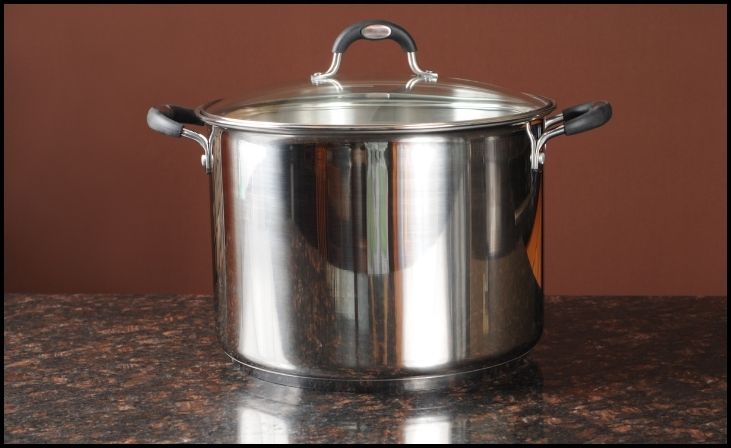
The Stockpot is a vast, deep, flat-bottomed pot. It’s used to prepare liquid items that don’t require immediate contact with the heat source. It’s great for simmering significant amounts of liquid like stock, soup, and stews and great for thick soups, chili, and boiling pasta.
This pot comes in various sizes, and it’s important to remember that having multiple sizes is useful when cooking for a small or large group.
The pot doesn’t need to be made of anodized aluminum or copper to promote rapid heat response, but it should have a thick bottom to prevent burning and scorching.
Size
Stockpots come in various sizes, ranging from 6 quarts to 20 quarts, and most come with a lid. However, standard sizes of 10, 12, and 14 quarts will cover many applications. Stockpots are available in various materials, including stainless steel, aluminum, anodized aluminum, copper, carbon steel, cast iron, and nonstick materials.
Our Recommendation
Tramontina’s 28 cm 11.9 L stainless steel stockpot with a flat lid, tri-ply base, and satin accent, you can achieve what you want with quality and efficiency.
In addition, its tri-ply foundation (stainless steel + aluminum + stainless steel) distributes heat consistently, ensuring food is cooked evenly, and speeding up the cooking process.
Fry Pan / Skillet
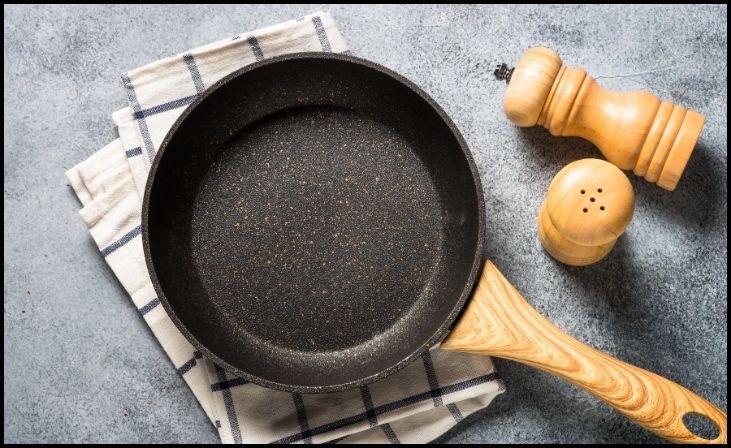
The fry pan, often known as a skillet or sauté pan, is one of the most valuable and versatile kitchen tools. With the correct fry pan, flipping omelets, stir-frying, and even scorching proteins is simple.
These pans have a flat bottom and curved sides, making them ideal for flipping foods or simmering with oils. When choosing your ideal frying pan, you should think about how many people you feed regularly and how much care you are willing to give.
How heat are they going to get? That depends on what type of material is used to make your pan.
For example, stainless steel pans can be used on high heat, while nonstick pans should only be used at low to medium heat to maintain their coating.
A heat-resistant heavyweight material, such as lined copper, stainless steel with a copper or aluminum core, cast iron, or anodized aluminum, is appropriate for a pot. Nonstick surfaces are also available on frying pans. It’s typically used for frying, although you can also use it to sauté.
Size
Frying pans come in various sizes, including 6 ½”, 7″, 8″, 9″, 10″, 11″, 12″, and 14″. They usually come with a cover and are available in depths ranging from 1 ½” to 3″.
Cast Iron Skillet
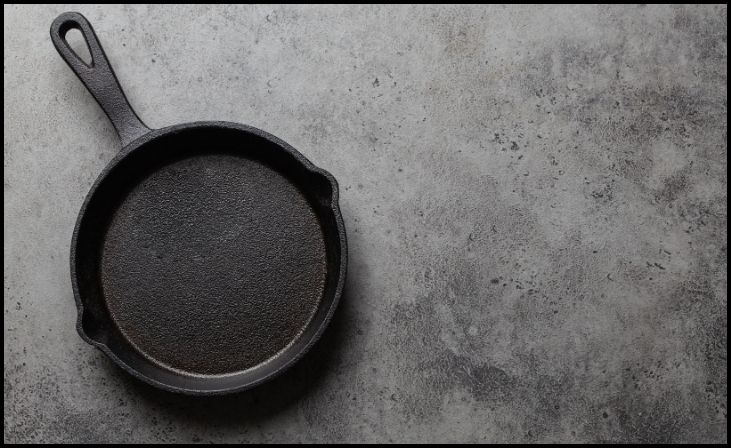
Cast Iron Skillets are another type of skillet. Cast iron skillets and fry pans may look similar, but they differ in how they are cared for and their material. Because they are cast iron, they can be quite heavy.
If you’ve never used a skillet before, the best advice is to come in and hold one before purchasing. Also, when purchasing a Cast Iron Skillet, make sure it is preseasoned. The problem with non-seasoned skillets is that food will stick to them.
Our Recommendation
Cast iron pans are made of an ultra-durable steel and carbon alloy that heats and cooks evenly and resists dents and scratches that other pans are prone to do. The Lodge Cast Iron Skillet, which functioned well, is recommended.
Check out our guide on The Best Cast Iron Skillet for Glass Top Stoves.
Sauté Pan

When it comes to design, sauté pans are similar to fry pans in that they both have a flat bottom. The primary difference is that sauté pans have straight edges instead of rounded sides.
Sauté pans are deeper than fry pans and can be used for various purposes in addition to sautéing. Deep-frying, searing, and creating certain sauces are just a few uses.
It is made of a heat-responsive material, such as lined copper, stainless steel with a copper or aluminum core, or anodized aluminum, and has a heavy gauge bottom.
The pan has a long handle and comes with a cover in most situations. Some of the more significant types have a loop handle on the opposite side of the long handle that helps lift the pan.
Size
The sauté pan comes in various sizes, with sizes varying from 6″ to 16″ and depths ranging from 2 ½” to 3 ½”.
Sauce Pan

The bottom of the Sauce Pan is circular, while the sides are tall and straight. Although the conventional saucepan has straight edges, several designs are available for specific uses. It makes them an extremely versatile cookware option since you can use them to make a variety of sauces and soups.
Saucepans are a must-have in any kitchen since you may use them to control evaporation with or without a lid. You can use a saucepan for various tasks, including reheating leftovers, cooking grains, and boiling eggs or noodles.
Saucepans are heat-resistant materials like lined copper or stainless steel, with an aluminum or copper core or bottom plate.
Size
They come in a variety of sizes. A small saucepan can accommodate 1 to 1 ½ quarts, a medium can hold 2 quarts, and a big saucepan can hold 3 quarts or more. A tight-fitting lid is included with most saucepans.
Our Recommendation
Tramontina 3-Quart Stainless-Steel Tri-Ply Saucepan With Lid, which functioned well, is recommended.
More Cookware You Can Add To The Collection
Cookware is a necessary component of any restaurant that delivers tasty sauces, casseroles, and sauteed vegetables. There are various options available for your kitchen needs.
Many of the kinds can be utilized in multiple ways. Some of the several varieties are listed below, along with a brief description of each. Let’s discuss the list of cookware in short.
Braiser Pan

Braiser pans, also known as Braisers, are huge, flat-bottomed pans with a moisture-sealing lid. This round or oval-shaped pan features a hefty domed lid and two stay-cool handles.
This pan is constructed of anodized aluminum or stainless steel and is heavyweight. An aluminum or copper core layer runs all the way through the bottom and up the sides of both types of materials, evenly distributing heat throughout the pan.
The Braiser Pan is a multitasker and a superb addition to any collection because of its design. Food can be browned on the cooktop or slow-cooked in the oven. Some braiser pans are even designed to be served immediately at the table once the food is cooked.
Size
They come in various depths and sizes, ranging from 10 to 13 inches in diameter, or 2 ½ quarts to 6 quarts, and 2 to 3 inches in depth. This pan could be used as a casserole dish as well.
Grill Pan

This heavy metal pan has evenly distributed ridges on its bottom that closely resemble the grilling process when preparing various meats and meals.
Similar to a frying pan, they come with shallow and deeper edges. The ridges lift the food off the pan’s bottom surface, preventing it from steaming as it cooks. The ridges also allow fat to flow out from the food and gather in the gaps between the elevated ridges.
Cast iron is commonly used in grill pans. Although it is necessary to season cast iron, some manufacturers offer enameled cast iron grill pans that have already been seasoned.
Cast iron pans are very heavy, and their handles heat up quickly, making them difficult to hold. Despite its size, cast iron is the greatest material for a grill pan because it retains heat and distributes it evenly.
Size
They come in round, square, and rectangular shapes, with sizes ranging from 9 to 12 inches. There are additional options for double burners.
Our Recommendation
Lodge 10.5″ Square Cast-Iron Grill Pan, is recommended.
Broiler Pan
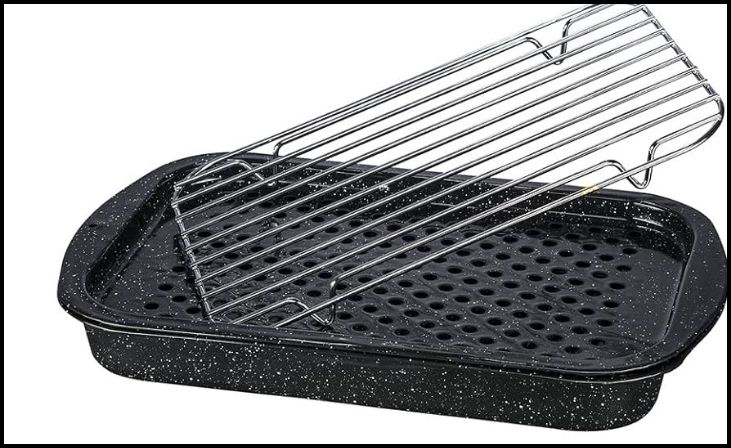
Broiler pans are made of stainless steel or heavy-gauge steel and have a black porcelain enamel finish. It comprises a low-walled pan section and an upper cooking surface that serves as the broiler plate lid.
The food is held in place as it broils by the cooking surface or cover, with open slits and small holes. As a result, the drippings are caught in the pan below.
The lid’s small apertures keep the hot fat and drippings contained in the pan, preventing it from flaming and burning the food while it broils.
The purpose of cookware is to broil foods such as steaks, roasts, or various cuts of meat, poultry, and vegetables in the oven. Broiler roaster, oven roaster, and oven broiling pan are all terms for the same thing.
Griddle
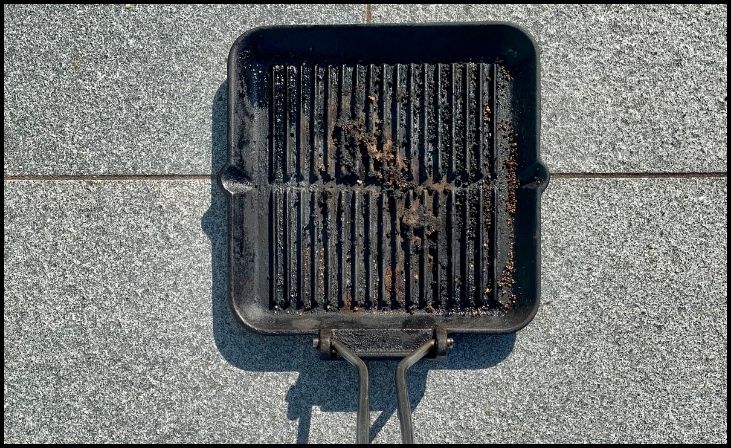
A griddle is a large, flat, or ridged piece of cookware. It is made of heat-conducting materials like cast iron or aluminum, with a nonstick surface and exterior for easy cleanup.
You can use it to make pancakes, hash browns, and eggs with a bit of oil. It can be square or circular, but it usually lacks the longer handle that a frying pan has. So when you’re attempting to get those ideal grill marks, griddles with a slightly ridged surface come in handy.
Size
Griddles come in various forms and sizes and are designed to be used over cooktop burners. There are circular or square griddles for one burner and rectangular griddles for two burners.
In addition, many heavy-gauge steel griddles are built with heat-distribution metals, ensuring that the cookware heats uniformly throughout the entire surface.
Wok
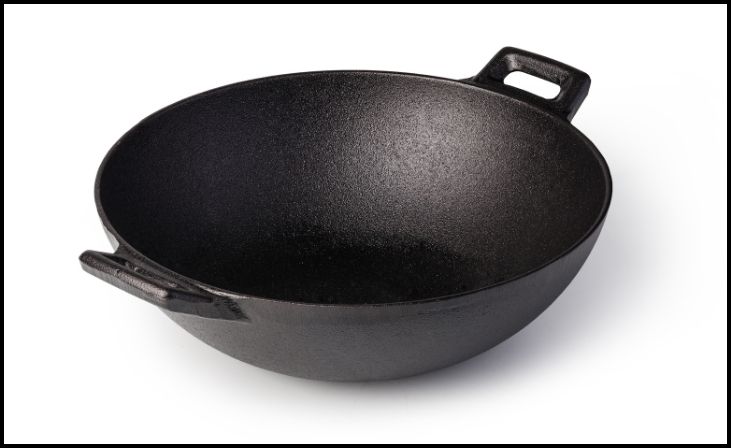
A pan formed like a bowl is used to cook food quickly over high heat. It has a rounded or flat bottom. The conventional wok has a round base and is used over an open flame, such as a gas burner.
The flat bottom wok was made to be used on an electric or ceramic stovetop, but you can use it on a gas stove. The rounded wok comes with a ring that goes over the flames to keep the woks stable.
Woks are a popular all-purpose pan with high, slanting sides. They have a 14-inch diameter and are composed of carbon steel. The bottom of these pans has a hot cooking surface, but the sides are cooler.
Woks come in various materials, including carbon steel, cast iron, stainless steel with aluminum inner layers, and metal with a nonstick coating. Before using a cast steel or cast iron wok for the first time, it must be seasoned.
The handles of some woks are long, while those of others are short. Some woks have both a long and short handle.
Size
The wok is about 4 inches deep and has a diameter of 12 to 16 inches. Stir-frying is the most common application for the wok, but you can use it for sautéing, steaming, and deep-frying.
Our Recommendation
Calphalon Premier 13″ Nonstick Flat-Bottom Wok, is recommended.
Casserole
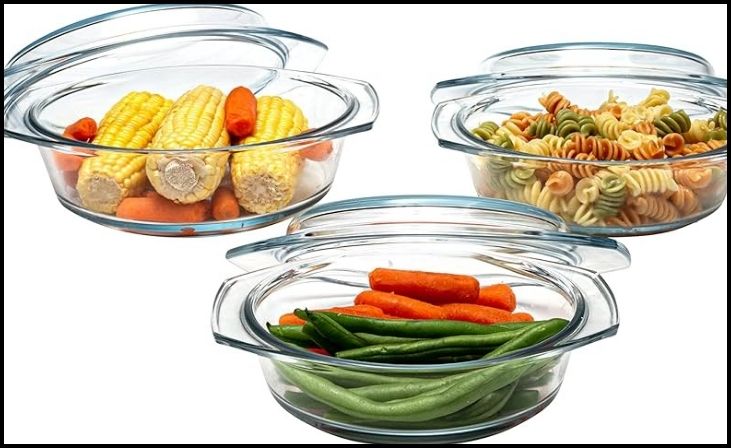
A casserole is a circular or oval pan with steep sides. The casserole pan is available in a variety of materials. It’s built of the same high-quality materials as a saucepan, or it could be made of glass, ceramic, or earthenware.
Although it may have a cover, the cover is rarely used when cooking food in a casserole. It can be used on the stovetop depending on the material, although it is most commonly used in the oven.
Chef’s Pan
The chef’s pan has a medium-depth pan with flared or rounded edges. It has a flat bottom and a broad opening, which helps liquids evaporate faster.
A chef’s pan usually has a long handle and a tight-fitting lid. It is made of metal with a deep ground foundation that allows rapid temperature fluctuations as the amount of heat changes, either increasing or decreasing for the best heat conduction.
Size
Chef’s pans come in various sizes, including 2, 3, 4, 5, and 6 quarts. Because of the height of the sides, it’s simpler to sauté, saute, or steam larger amounts of food while it still has enough room to turn and stir the contents. Chef’s pans and saucier pans are quite similar and can be used interchangeably.
Chestnut Pan
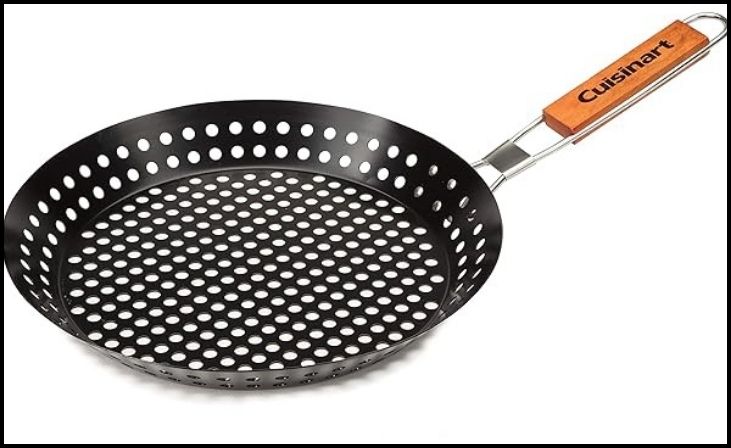
This roasting equipment, shaped like a wide-walled pan or a skillet, is made for roasting large, brown shell chestnuts over a stove or heat source like fire, gas, or hot coals.
A longer-handled roasting pan made from steel wires, such as a steel frying pan, is suitable for roasting over an open fire, but a deep-walled or skillet-like pan is best for coals, gas, or electric heat.
The Chestnut Pan is designed with wide holes in the bottom to allow the heat to heat the chestnuts in their shell while they cook directly.
Double Boiler

A double boiler comprises two pans, one of which sits inside the other. The bottom pan is slightly larger to accommodate the top pan. The bottom pan is filled with boiling water, while the top pan holds the cooked items.
Double boilers are commonly made of stainless steel, although they can also be made of enameled steel, aluminum, or glass.
Dutch Oven
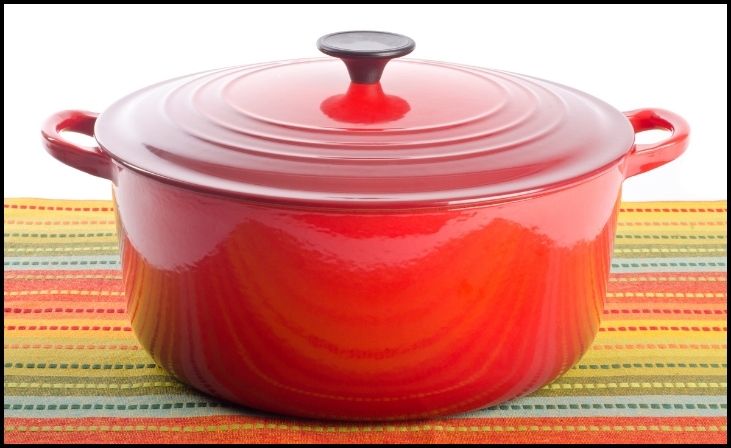
A heavyweight, round or oval pot that has a domed cover. The sides of a Dutch oven are steep. Stainless steel, anodized aluminum, and cast iron are used to create them.
The Dutch Oven is a massive vessel with a slow-cooking function. They’re great for pot roasting, stewing, braising, boiling pasta, and soup. You may use them in the oven as well as on the cooktop.
The majority of Dutch ovens have a pair of small handles to make lifting safe and simple.
Size
They are 2 quarts to 6 quarts in capacity and range in depth from 2 to 4 3/4 inches. Many chefs prefer Dutch ovens because they provide a burst of color to any cookware set.
Our recommendation
Le Creuset Signature Enameled Cast-Iron Oval Dutch Oven is the best buy.
French Oven
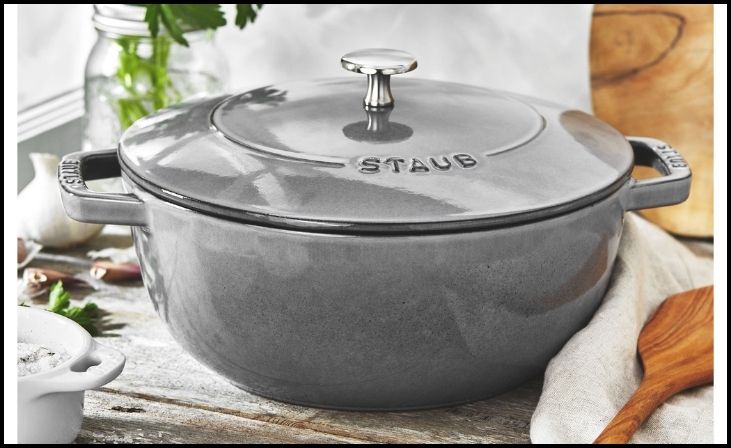
The French Oven is similar to the Dutch Oven, except that it has an inside enamel coating that eliminates the need for seasoning. That is why Enameled Dutch Ovens are usually used to refer to French ovens.
Beef, Pig, roasts, briskets, and fowl are all good choices for cooking in French ovens. In addition, French ovens are available in various colors like ordinary Dutch ovens, making them a great way to add a splash of color to any cookware set.
Sautéing Pan
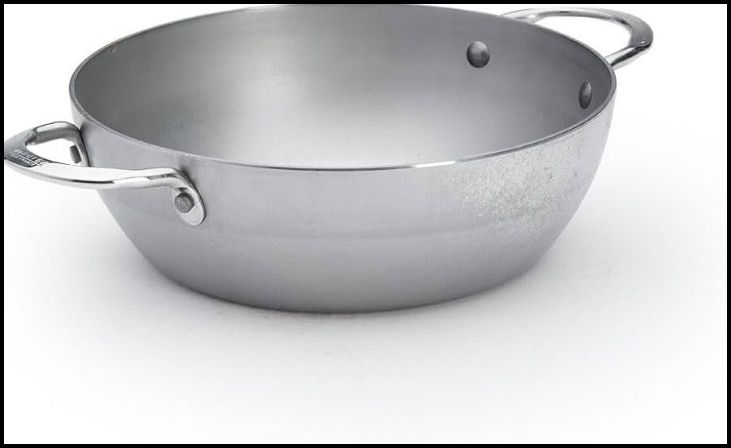
Sautéing pan has short, straight edges similar to a frying pan. It is made of a heat-responsive material, such as lined copper, stainless steel with a copper or aluminum core, or anodized aluminum, and has a heavy gauge bottom.
It’s typically used for sautéing, but you can use it for frying. The pan has a long handle and comes with a cover in most cases. The sauté pan comes in a variety of sizes.
Meatloaf Pan
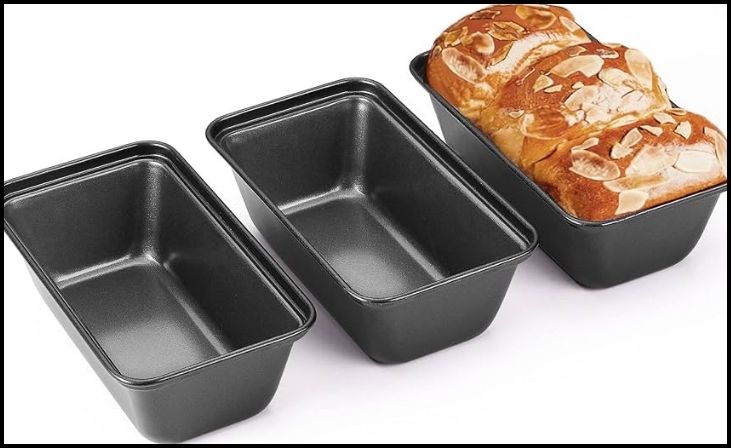
This sort of pan, which looks like a regular loaf pan, is designed to allow fat and drippings to drain as the loaf bakes. They’re made up of two pans, one that fits inside and above the bottom or base pan and the other that sits on top of it.
As the food bakes in the top pan, which has multiple holes, the grease, and fat drip into the bottom pan, placed underneath the pan. The elimination of the drippings may result in slightly drier meat as it cooks, but it does prevent the meat from baking in grease and fat.
As a result, loaf Pans are also known as Low-Fat Loaf Pans.
Roasting Pan
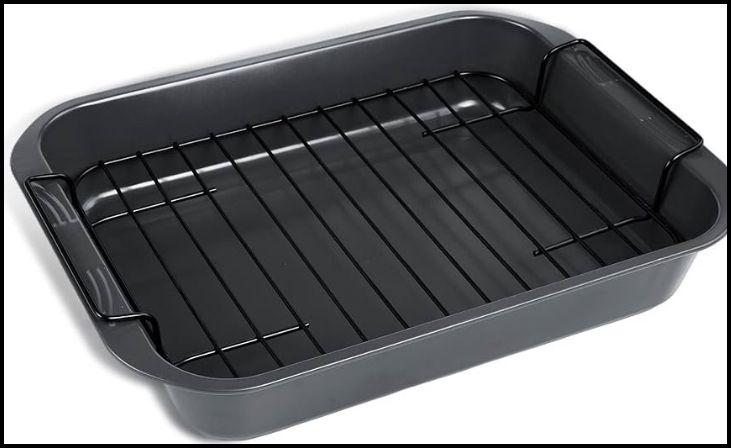
Roasters are large rectangular pans with low sides that allow the heat from the oven to reach the entire surface of the meat, resulting in a browned exterior. A roasting rack, which helps lift food above the cooking surface, is frequently used with roasting pans.
It’s great for cooking at relatively high temperatures in the oven’s dry heat. It is a must-have pan for roasting turkeys, chickens, and other roasts.
Stainless steel, anodized aluminum, lined copper, stainless steel with an aluminum or copper core, aluminum with nonstick surfaces, and granite are the materials available for roasting pans.
Cuisinart MultiClad Pro 6-Quart Stainless-Steel Roasting Pan With Rack is the best buy.
Roasting Pans with High Cover
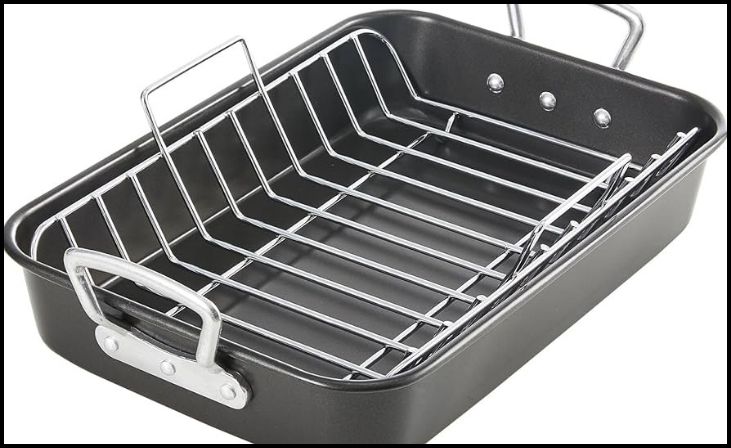
The pan is oval in shape, with deep sides and a large domed lid. A flat rack is usually put on the bottom of the pan. Roaster pans come in various sizes and materials, including granite, anodized aluminum, and stainless steel.
As the meat is cooked with the cover on, it works as an oven within an oven, resulting in faster cooking and a moister cooking environment.
As a result, the meat is juicy and tender. Casseroles are made in a deep-sided roasting pan that does not have a cover.
Stir-Fry Pan
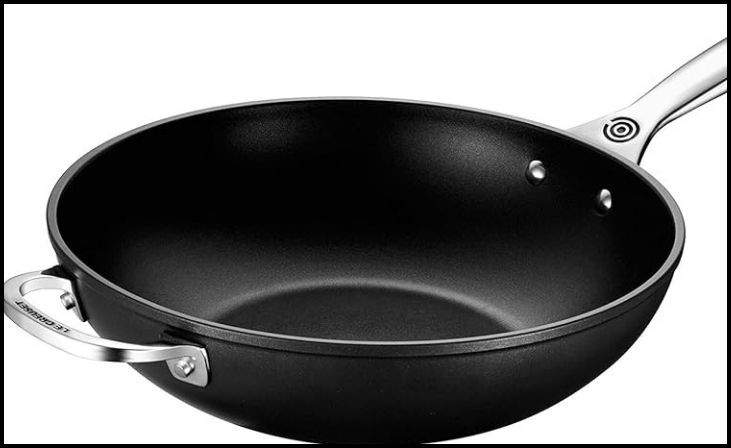
Stir Fry Pans are deep, spherical, with straight sides and a gently rounded base, or a round base that slopes outward. Stir fry pans come with various handle lengths to fit any cooking situation.
The sloping edges make it simpler to stir and turn ingredients as they cook, and the pan allows heat to be evenly spread throughout the base.
A typical type of stir-fry pan is an Asian pan known as a “wok,” however alternative variations are often available with thicker bases and sides that are not as curved or as deep as the wok pan.
The stir fry pan is ideal for cooking food with little oil while preserving the colors and textures of the various ingredients.
Glass Baking Pan

Tempered glass is used to make this baking pan. The glass can be flameproof or ovenproof, and it comes in a variety of square and rectangular shapes.
You can use flameproof glassware in the microwave, cooktop, and oven. And Ovenproof glassware in the microwave and the oven, but not on the stovetop.
Fish, meats, casseroles, vegetable dishes, bread, cakes, and other delicacies are all baked in the glass baking dish.
Gratiné pan
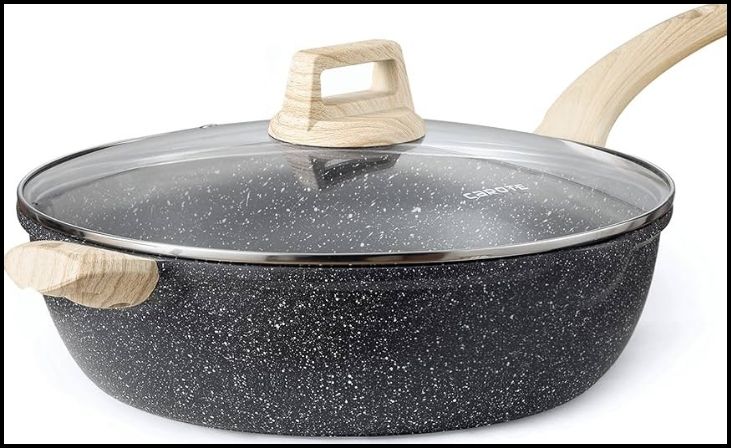
A gratiné pan is used to prepare a typical French dish with a brown crispy top crust. The dish is usually an oval-shaped shallow-sided container, although it can also be spherical with deeper sides than the oval-shaped pan.
The Gratiné Pan, made of aluminum, steel cast iron, or stoneware, permits the food to cook uniformly and in the same amount of time as the crust browns.
A gratiné is a golden tan crust often created as a casserole, a potato dish, or a vegetable dish browned in a broiler oven to generate the core aspect of this food: the golden tan crust. Au gratin is another name for gratiné.
Omelette Pan
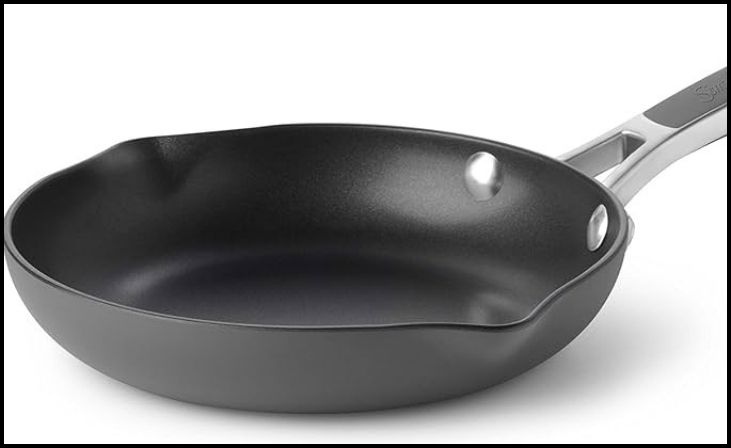
An omelet pan is very similar to a frying pan. It’s composed of the same type of material as frying pans and has a similar form. A nonstick omelet pan is beneficial since it allows the eggs to release from the pan, making them simpler to turn or flip.
Size
It is of oval shape, which is 10 to 12 inches in length. Foods like omelets, salmon fillets, and shell steaks work well in the oval pan. Round pans come in various sizes, including 8, 10, and 12 inches.
Paella Pan

The pan is a shallow skillet-like pan with a large diameter and is made of cast iron, enameled metal, or brushed aluminum.
Size
Although some pans have higher edges, resulting in a deeper pan, traditional pans have a diameter of 14 to 16 inches and the appearance of a medium to large skillet with a shallow depth.
The majority of paella pans feature handles on both sides.
Sauteuse Pan

Sauteuse Pan is a spherical, covered pan with tiny handles that is frequently used to sauté or braise a wide range of meals.
Size
This pan, which has a little curved handle on each side instead of a single straight handle, comes in sizes ranging from 2.5 quarts to 7 quarts.
A sauteuse pan is a tool for cooking casseroles, stews, pasta meals, and meat and poultry dishes.
Fondue Pot

The word fondue derives from the French verb fondere, which means “to melt.” This type of cookware comprises a pot with a heat source such as an electrical heating element put immediately below the pot and is used for fondues.
Depending on the cuisine to be made, you may fill the pot with cooking oil, wine, cheese, chocolate, or other things. The heat source melts or fully warms the contents, allowing food to be dipped into the pot and cooked or coated.
Pressure Cooker
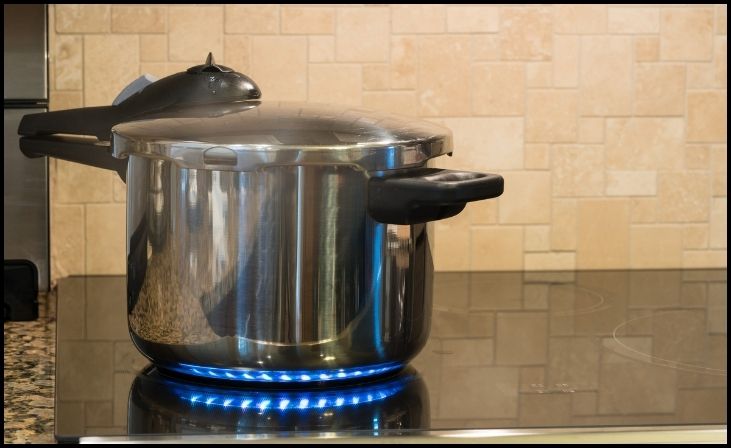
Quick-release options are available in pressure cookers, allowing you to finish a meal in even less time and without wasting water cooling it down. While the liquid within the pot is boiling, their lids completely seal the pot.
The pressure is then built up by steam, resulting in higher cooking temperatures and shorter cooking times.
The pressure in a pressure cooker with a detachable pressure regulator can be set to low, medium, or high. The higher the pressure, the higher the internal temperature, and the faster you can cook.
The steam will be vented automatically by the safety valve.
Types of Cookware Handles
Riveted
Pros
- Sturdiest available
- It never needs to be tightened
Cons
- Harder to clean than other types
Welded
Pros
- Present a uniform construction
- Allows for a smooth interior
Cons
- Not as sturdy as the riveted option
Screwed On
Pros
- Easy to replace the handles
Cons
- Require occasional tightening
Microwave Cookware
Microwave cookware is different from other types of cookware. Most cookware designed for use on the cooktop or in the oven will not work in a microwave.
Microwave cookware is typically constructed of glass, ceramic, or plastic, although not all of these materials are microwave safe. If a container is not microwave safe, it will heat up and create a safety concern in the microwave.
Most plastics, but not all, can be used in a microwave oven. They should be capable of surviving the heat from the microwave if their label indicates that they can tolerate boiling water and are dishwasher safe.
It would be best if you used Heat-resistant glassware in the microwave. However, the microwave’s high and uneven heat is too much for the non-heat-resistant glass to handle. Instead, unglazed ceramic cookware is recommended.
Glazed ceramic absorbs microwave radiation too quickly, causing it to crack or overheat to dangerous temperatures. The ideal microwave cookware is a dish with shallow sides and a round or oval shape. Microwave cookware sets include a variety of sizes and shapes of microwave-safe containers.
Cookware Sets
There’s also the option of purchasing cookware in a set. It’s usually an excellent way to save money while still having matching components. But, again, this is an option for people who know what they want, making it easier to purchase.
Cookware sets can range from 10 to 18 pieces, with multiple variations in each set to meet your specific needs.
There are another few more things to consider once you’ve decided on a cookware set: Although many cookware sets are dishwasher safe, we recommend hand washing them to extend the life of your cookware.
Also, consider heavier pots and pans if you want the greatest cookware set because they are made of higher-quality materials and are more secure, but make sure you can easily lift them off the burner.
Finally, no one type of material is superior to the others. Depending on your specific cooking requirements, they are all equally advantageous.
For more in-depth Read our Cookware Set Guide. Also Check, Cookware Buying Guide
Making The Final Decision
Whether it’s just pots and pans or complete cookware sets, Nonstick cookware is an excellent investment that makes cooking a breeze.
However, it’s vital to remember that you must use the proper tools to avoid scratching the nonstick coating when using nonstick cookware. It is feasible to obtain cookware suitable for use with metal utensils.
Dishwasher-safe, oven-safe, and shatter-resistant pots and pans, for example, will significantly enhance your cooking experience, allowing you to spend more time focused on the food creation and less time on safety and cleanup.

Leave a Reply